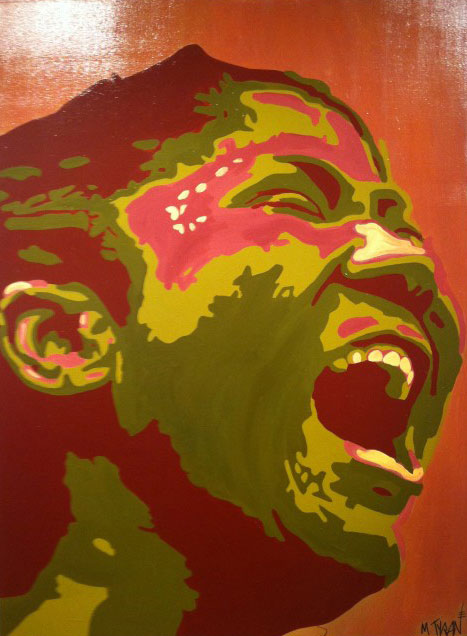Lift Every Voice

Monica Tyran, Mahalia. Courtesy the artist and Stella Jones Gallery, New Orleans.
Editor's Note
Welcome back, readers!
"Mahalia Jackson: Queen of Gospel Music" is now traveling to the African American Museum in Dallas. As the 40th anniversary of the singer's death approaches, Lauren Scarpello weighs in on the exhibition's run at Stella Jones Gallery in New Orleans, where it originated in October 2011 on the 100th anniversary of Jackson's birth and closed on January 6, 2012.
When gallerist Stella Jones heard that the city of New Orleans had no plans to formally pay tribute to native daughter and gospel legend Mahalia Jackson on the 100th anniversary of her birth, she decided to take matters into her own hands. Jones invited approximately 50 artists—over half from Louisiana and the majority of whom have an existing relationship with the gallery—to create work for a show in Jackson’s honor, drawing inspiration from her music.
Much like a choir, the artists bring their individual voices to the exhibition and yet collectively create one sound. The strong visual unity between pieces and across media clearly demonstrates that the artists did indeed listen to Jackson’s music while creating, but the unimaginative range of interpretations begs the question if perhaps they were all listening to the same song. The paintings and drawings—mostly portraits—consistently display saturated color, folk art elements, and the iconography of praise and worship—doves, church fans, and crosses. A segmentary technique akin to stained-glass windows makes a repeated appearance in works such as Najee Dorsey’s Lift Us Up O’Lord and Malaika Favorite’s Nothing but the Blood.
The sculptural pieces, however, are less didactic. Recurring organic forms subtly speak to the universally humanizing power inherit in Jackson’s voice. One such example is the posthumous display of Donald Locke’s sculpture. Three jade-colored, semi-circular ceramic forms sit proudly atop pedestals of varying heights. Elephantine trunks—one draped with pearls—protrude from the femininely bulbous bases, which also bear swatches of rich fur. The abstract forms function as talismans of the outward signs of wealth Jackson began to show as her social status, fame, and popularity increased following her migration to the North.
In speaking about the show, Jones cited that one of the unexpected benefits was that a diverse audience of individuals who might not normally be drawn to the historically African-American gallery found themselves gathering there in mutual respect and admiration for Jackson. Artist Cynthia Ramirez’s standout Day of the Dead Altar and accompanying Day of the Dead celebration in November brought in members of the Latino community who congregated to celebrate Jackson’s soul. The altar, bearing Jackson’s portrait, was draped with traditional Day of the Dead artifacts—sugar skulls, flowers, and candles—and also incorporated objects special to Jackson in life—foods she loved and her favorite perfume. It is just one example of the far-reaching impact Jackson’s voice has had on artists and fans outside of the African-American gospel community. Nearly 40 years following her death and the shepherd still commands the gift to unite her disparate flock.



